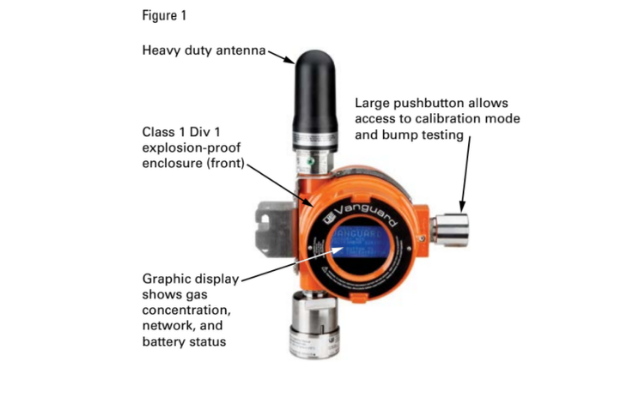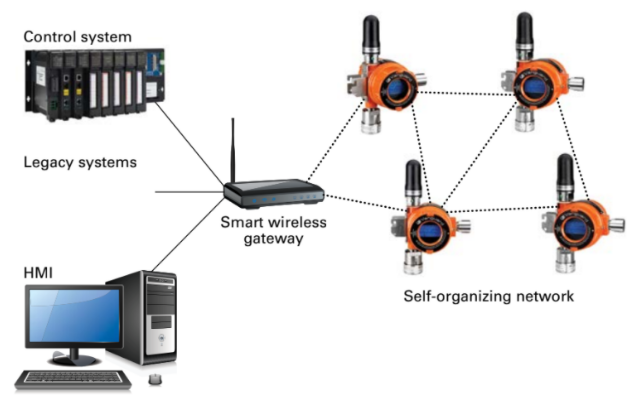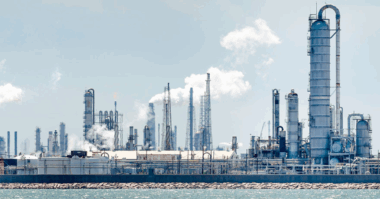The emerging solution for improving plant safety
Contributor: Wil Chin, Vice President of Marketing and Business Development at United Electric Controls; Joe Mancini, Senior Product Manager at United Electric Controls; Greg LaFramboise, Retired Wireless Technology Lead, Chevron
Industrial processes such as oil and gas production facilities, refining, chemical production and power generation often involve toxic and combustible gases, which can create serious hazards if they escape into the air. Toxic hydrogen sulfide (H2S) and combustible methane (CH4) are among the most widely produced and most dangerous industrial gases.
To minimize risk to personnel and plant safety, plants often deploy early warning devices such as gas detection systems, which require expensive infrastructure and seldom cover all of the potential leak points. As public concern about plant and community safety grows, however, interest in expanding coverage grows as well. And this comes at a time when market forces are placing companies under increasing cost constraints, pushing plant safety managers to seek innovative ways to reduce plant risk with limited additional investment.
This concern is driving a trend toward augmenting existing wired gas detection coverage with wireless sensors, which can significantly increase monitoring coverage with minimal new financial outlay. Contributing to this wireless trend is the evolution of the Industrial Internet of Things, in which companies are not only gathering more data from process points, they are also becoming more adept at using it strategically.
Gas sensor basics
A typical gas detector identifies and monitors gas leaks, outputting an electronic signal such as a 4-20 mA, HART, or Modbus wired signal, to a dedicated fire & gas (F&G) system, controller, PLC or control room which sets alarms or guides corrective action. For toxic gases, those signals represent the presence of gas in parts per million (PPMs). For combustible gases they represent the percent of the the lower explosive limits (LELs).
A number of technologies are used to detect the presence of gases. Infrared (IR) technology, which is among the most commonly deployed, monitors gas concentration based on the principle of infrared absorption. Gases like methane absorb specific infrared wavelengths. The electronics module computes the gas concentration based on the amount of absorption.
Electrochemical sensing, another commonly applied technology, measures the concentration of a target gas by reacting with the gas and producing an electrical signal proportional to the gas concentration. A typical electrochemical sensor consists of a sensing electrode and a reference electrode separated by a layer of electrolyte.
Sensing technologies vary in reliability, depending on the properties they are measuring and on the types of gases involved. Electrochemical detectors, for example, tend to be more reliable for specific gases, like hydrogen sulfide, but may lose effectiveness after continuous exposure. Infrared technologies, on the other hand, tend to be more reliable for detecting LELs and may perform well for up to five years or more. In addition to the sensors deployed in gas detectors, a detection system typically includes a controller or a plantwide fire & gas control system with HMIs, alarm systems, and relays connecting to valves, pumps, or whatever final element might be needed to suppress a gas leak and/or HVAC and fire suppression systems to suppress a fire.
Gas detection system architecture
Gas detection is a power-hungry operation, so the main system must be wired to a power source. The cost of such systems, including the cost of planning, design and running conduits for power and signal wires, trenching, and other installation details, can be in the neighborhood of $10,000 per device. Gas detection systems covering all critical plant points have traditionally been specified at the front end engineering and design (FEED) of the plant design, but coverage for all possible points is typically not financially feasible. Furthermore, most of the legacy gas detection systems in use today were specified prior to plant expansions and increased safety awareness.
However, as significant incidents and new standards drive heightened interest in plant safety, and as plant systems age and experienced workers leave the workforce, there is a need for tighter monitoring of gas leaks. Filling this need with wired sensors is prohibitive, not only because of the wiring expense, but for many sites, because there is minimal workable space to add wiring or other necessary infrastructure.
Personal or wearable gas detectors can provide a layer of protection, but the accuracy of these devices is poor with 20-25% accuracy as reported by experts in a recent National Fire Protection Association (NFPA) conference. NFPA speakers highly recommend augmenting of personal devices with more reliable fixed gas detectors in potentially dangerous areas. Installing fixed detectors, would better warn workers against entering dangerous areas, protecting them from harm. Regardless of whether a company is deploying fixed or personal detectors, the detectors should be networked so workers in the vicinity are aware of the hazardous condition.
The wireless connection
Wireless technology removes the physical and economic barriers associated with wired gas detection devices. It can save up to 90 percent of installed cost and time and can be applied in both field and plant networks, detecting leaks that might not otherwise be detected by sparsely distributed wired units.
Just about any type of wired sensing technology can be adapted for wireless and some incorporate multiple capabilities, combining both IR and electrochemical for example. At the sensor level, there is little difference in the basic technology deployed between a wired and a wireless gas detector. However, using sensors designed for wired gas detectors in a true wireless (no power and signal wires) application, would be impractical as batteries would require replacement in months instead of years.
Figure 1 shows the exterior of a wireless gas detector with all of the built in protections necessary for deployment in inside and outside hazardous area locations. It shows the antenna by which it communicates with its host. The housing should be rated Class 1 Div 1 explosion proof, and there should be a graphic display that shows gas concentration, network, calibration, temperature and battery status. Accessible field connection points should be rated intrinsically safe for Zone 1, allowing connection to a hand held communicator for configuration and testing as well as for swapping out sensor types without a hot permit.
Once the sensor takes the measurement, the wireless devices send signals to a wireless gateway which can be connected to a fire & gas control system, distributed control systems (DCS) or programmable logic controller (PLC) host for processing. The wireless signals may be designed using any network protocol, although, as will be discussed later, standard open protocols such as Wireless HART have specific advantages.
Applications
Unlike wired gas detection systems, which have expensive infrastructure requirements, wireless systems can be deployed just about anywhere there is a potential for a gas leak. The most likely applications include remote and local detection, temporary situations and monitoring to improve asset management.
Wireless remote and local gas detection Tank farms, oil and gas production facilities, refineries, pipelines, abandoned wells and waste treatment plants are all good candidates for wireless gas detection.
Tank farms. Storage tanks are one of the most common sources of gas leaks. They are always located some distance from the central facility and sometimes near residential areas. If the wind is blowing away from any wired detectors onsite, for example, plant operators may not know of any leaks until residents call in complaining about the smell. Multiple sensors could cover more tanks, and they could all be networked through a common gateway.
Oil and gas production facilities and refineries. Wireless monitors can provide additional protection for workers in refineries. If the wired detection system is not up to current standards and/or lacking coverage due to plant expansions, the workers and the community may be at risk. A typical inside the plant application might include setting a local field mounted PLC to operate a ventilation system or shutdown routine based on a signal from the wireless monitor.
Pipelines. The pipelines that transport hydrocarbon products to and from wells, tanks, and processing and storage facilities are another common source of leakage. Breaches at these facilities are quite prevalent today. The pumps, valves, couplings, flanges, pipes and other trappings surrounding the piping are all vulnerable to age, installation errors and trauma. Some of these components are underground, so finding them is even more difficult. With hundreds of miles of pipes, it’s impractical to deploy thousands of local pipe leak detection devices necessary to cover the leaks within pipes.
Plugged and abandoned wells. Capping an abandoned well in concrete does not guarantee that it won’t leak, but because it is not operating, no one is around to notice problems and there is little incentive to invest in wired detectors. But leakage could result in risk to the area, fines and other problems and an easily deployed wireless solution could be very valuable.
Wastewater treatment plants. Pollution control is another area rife for improved gas monitoring. Waste produces methane which is highly combustible but few municipalities have the resources to devote to wiring up waste locations. Yet the risk is significant and can be mitigated with the installation of inexpensive wireless monitors on anaerobic digester tanks, solids landfill or other vulnerable points.
Temporary situations
In some cases it may be necessary to monitor gas in situations in which the cost of setting up a wired solution is completely unfeasible. A planned maintenance turnaround, for example, might involve activities which could potentially introduce gas leaks into the area. A wireless system could be deployed during such operations and relocated once the shutdown is complete. Other temporary situations might include the aftermath of a natural disaster, a security breach or a plant expansion project.
Asset management
The ability to deploy multiple sensors wirelessly can also provide predictive and preventive maintenance capabilities that wired systems cannot provide cost-effectively. Measuring the amount of background hydrogen sulfide and methane in the air and comparing it over time trends can detect an early indication of a problem. The sensor would pick up on this and send it to an asset management application, which might track increases in methane and/or H2 S and compare it to other areas, and historical norms. Analysis of changes could reveal potential dangerous trends early enough so that they can be corrected. Maintenance can be dispatched to affected areas for detailed investigation and needed repair in lieu of checking everywhere during routine maintenance rounds. For systems carrying risk of gas leakage, wireless technology can be the heart of a cost-effective reliability-centered maintenance program.
Operating issues
In addition to the basic sensing technology, battery life and interconnectivity represent two of the most critical operating issues that wireless gas monitoring will raise.
Battery life. Battery life is a key variable in both the economics and performance of a wireless monitor. The more remote the location being monitored, the greater the role of the battery in maximizing safety at a low cost. Newer systems use lithium metal technology which, combined with low-power components and advanced power modules, can extend life well beyond 5 years, significantly greater than current offerings operating under the same conditions.
Affecting battery life in addition to its metallic composition, is how well low-power components like display and sensory assemblies feed the circuit board, how often they are pinged for a message, and the speed at which the message is transmitted. A typical gas monitor could be configured to send readings at any interval, from seconds to hours or more, depending on the need for information and the desired battery life and the speed at which the sensor can actually collect data. Furthermore, prudent wireless network design (how the wireless sensors are laid out) should be considered, and can help to maximize battery life.
Interconnectivity. Your plant IT personnel will need to be involved in the deployment of a wireless gas monitoring system in order to connect the wireless network to plant monitoring and control systems. They will need to know exactly how the device will join their network and how it is communicating data, which is a function of the communications protocols.
How the system ties into the control system depends on the wireless protocol selected. A device supporting WirelessHART, for example, would automatically join an existing HART network, which is the most commonly deployed protocol. WirelessHART is a globally approved standard (IEC 62591) that promotes an interoperable, self-organizing and healing, mesh technology, which is secure, reliable, and easy to use (Figure 2). A communication protocol like this can improve reliability by enabling the signals to find the best signal paths to deliver rich diagnostic information about the gas detector.
In addition to communicating gas concentration values in PPMs and %LELs, a WirelessHART enabled gas detectors can also transmit information on battery life, temperature and date of last calibration.
Because the HART protocol is so prevalent, WirelessHART has many advantages, but other proprietary communications protocols may have their advantages as well. They would require the end user to own the vendor specific gateway or controller and to utilize their software, but if they are already invested in that it may be the more desirable option. A more open protocol, however, has the advantage of being able to communicate with a wider variety of devices, and support for industry collaboration initiatives such as the Field Device Integration (FDI) initiative. With many users deploying WirelessHART networks for monitoring pressure, temperature, and level, WirelessHART gas detectors can simply drop into these networks without additional software, or investment.
In many cases, the IT team will be responsible for managing the entire plant wireless network, so they will need to know about the standards and security properties of the sensor as well as details about range, speed, interference, and other networking factors, all of which should be available from the device vendor or the FieldComm Group that manages the WirelessHART standard.
The IT team will also be concerned about cyber security. Cyber security vulnerability is primarily a function of the communications protocol. WirelessHART, for example, is well encrypted. End users of course, should also work with their IT teams to be sure their network is covered by existing firewalls, intrusion prevention, intrusion detection, and other cyber security technologies and policies that may be in place.
Ever-present need
The technology for wireless gas monitoring has developed significantly. As more end-users adopt wireless devices at the field and plant level, they will likely become an increasingly important fixture in the industrial landscape.
If prices pressures continue to mount in the hydrocarbons industry, for example, the need for safety will not go away and the need for cost-effective solutions will grow.
As market conditions improve, the increased volume of hydrocarbon processing activities will introduce more potential leakage vulnerability and greater need to assure stakeholders that producers and transporters are doing everything they can to ensure safety.
Regardless of which direction the economy takes, the Industrial Internet of Things is coming and there is little doubt that some of those sensors transmitting data into the cloud will be wireless and configured to protect against potentially harmful gas leaks.
Wil Chin is Vice President of Marketing and Business Development at United Electric Controls, in Watertown, Mass. Prior to that, he was a research director for the ARC Advisory Group covering asset performance management, condition monitoring, plant asset management, field devices, control valves, communication protocols, and wireless technology. He has also held technical and marketing positions at Krohne and Foxboro (now part of Schneider Electric). He can be reached at wchin@ueonline.com.
Joe Mancini is Senior Product Manager at United Electric Controls, in Watertown, MA. He is currently responsible for new product research and strategic direction. Prior to that, he was a Product Manager at UE, having successfully launched UEC’s first HART enabled product, and managing its oil and gas product portfolio. He can be reached at jmancini@ueonline.com
Greg LaFramboise was Wireless Technology Lead for Chevron before retiring in late 2015. In his 35 years there, he had been involved in all parts of instrumentation and controls for most of his career. Over the last decade with Chevron, he served as Wireless Technology Lead promoting the development of wireless sensors within the company. He served as chair of ISA 100 User Group and ISA 84 Wireless for the Safety Working Group. He has worked with industry and research groups to develop new sensing technologies compatible with industrial wireless technology in order to improve facility operation and integrity. He remains interested in continuing development in new sensing technology areas.





